| 1922
- 1983 / 600,000+
(*) |
1922 - 1983 /
xxx (*) |
1922 - 1967 /
21,505 |
1922 - 1983 /
xxx (*) |
1922 - 1983 /
xxx (*) |
|
(*)Final
numbers not yet available - shown in red. |
The register opened on 30th September 1921.
The first state registration badge was issued to Ethel
Gordon Bedford-Fenwick (nee Manson) who was registered as SRN (State
Registered Nurse) on 30th September 1921. The registration number was
'1'.
The final resting place of this badge is unknown.*
The publication of Register of Nurses commenced in 1922 and the Register
closed in 1983. The issue of badges corresponded with the opening of the
register in
1921, and ended with its closing on the
'disestablishment' of the General Nursing Council for England and Wales on
1 July 1983 under Section 21, Nurses,
Midwives and Health Visitors Act 1979. Something in the region of at least 600,000 SRN badges, probably very
many more registration badges if all specialties are included,
had been issued.
Collecting.
During the lifetime of the GNC collecting these badges was something
of an underground activity. The council laid claim to every badge issued
from the outset. On the death of the original recipient the badges were to
be returned to the council. Presumably that also applied to badges issued to a living nurse 'struck off'
the register for any reason. There were of
course good reasons for this, as a GNC badge could possibly be used to fraudulently lay claim to be
a registered nurse. That
title 'Registered Nurse' has been a legal designation since 1919. What happened to returned badges is not
clear, but it is difficult to imagine that all were destroyed -
particularly in the cases of the badges of the more prominent
members of the profession. Following the 'disestablishment' of the council a large
number of GNC badges have entered the public domain and are easily
purchased, many for quite small sums of money. Auction sites, sale
rooms, flea markets and car-boot sales up and down the county are some common sources.
Some of these badges, however, will probably remain in the possession of the original recipients
descendants for generations as family heirlooms. Many of these enter the
open market eventually for various reasons. That may well change if the
growing popularity of genealogy - tracing family roots - continues.
Badge identification:
Anyone collecting registration badges issued by the GNC should bear in
mind that not all badges can be identified in the
same way. All GNC registration badges have the same face side design carrying
the emblem the emblem and title of the GNC,
but there the general similarities end.
Earlier badges, 1922 - 1940, were made of
sterling silver and carried much detail of the recipients
on the reverse side. Name; specialty;
registration number and date of registration as well as maker marks;
hallmarks on silver versions; pins; loops for safety chains and even
lapel button-hole fittings where this had been requested. These details are sometimes
invaluable, for example when attempting to trace an exact badge origin,
or perhaps help validate the professional history
of a nurse.
But in any event they probably make the earlier registration badges generally far
more desirable to collectors.
1940 was a watershed as far as materials are concerned - marking the
issue of the last generally issued silver badges and the first chromium
plated versions. The exact date is currently unclear making the
detection of the last and first versions of each nebulous.
All badges after 1940 were manufactured from a chromium plated
base metal and until about the early 1970's carried the same detailed
information on the reverse as the earlier badges. Though the information
was not uniformly laid out on early badges.
Later badges, commencing in the early 70's, were inscribed with only the specialty and
registration number of the nurse. A measure implemented in an attempt to
thwart impersonation of registered nurses - of which there had been
successful cases. The linking of these
numbers to an individual nurse is not generally possible without access
to the appropriate GNC register, precisely
because only the
registration number and the specialty of these later badges are
inscribed. Likewise, a nurse's training school and hospital cannot
be easily linked to a particular GNC badge, but then this applies
to all badges irrespective of when they were issued. In some ways that is a regrettable, hiding some of the true
origins of a badge - some of it's history, but in other ways it may be a
blessing - deterring idle curiosity! It is also one reason why
'badge sets' - comprising the GNC badge and at least one other badge -
usually that of the nurses training school or hospital are popular with
knowledgeable collectors.
So, as a general rule, we have two basic designs of GNC registration badge. The early
silver variety, and the later chromium plated base metal variety. The
latter had less information inscribed on the rear from the early 1970's.
But there are exceptions to every rule...
| And this may well
be |
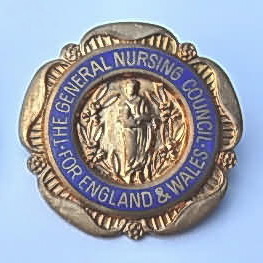 |
the only one recorded. |
The
Exception: In the case of the state registration badge there is but this one
recorded exception, pictured above, known to exist. It is in a private
collection. A gold-coloured metal GNC state registration badge - possibly a
prototype for the chromium plated version introduced in 1940/41. Like a
misprinted stamp or currency note little is known about the origins of
this badge, although this may be recorded somewhere in the Thos
Fattorini archives. The best theory is probably the prototype idea.
THE SPECIFICS
There are two basic groups of specific
characteristics to consider. The first - characteristics which are by all genuine
GNC registration badges share in common; and the second - differential
characteristics - differences. The latter are characteristics which are slightly different between individual
items. These are the differences which render the badges so
collectable, enabling for example, the detection of historical differences,
such as accurate dating. Or the individual differences in inscriptions
markings, which makes collecting these badges extremely interesting and
attractive.
.
Characteristics in common... (Click
Here to view diagram)
All state registration badges have three major characteristics in
common. Firstly the face side; secondly the outline shape; thirdly the
weight.
The face side:
This is the most striking feature - the one which attracts the most
immediate attention. Probably the one which makes the badge so attractive to
collectors, though that was never the intent.
The shape, in relief, is based on a rose - the symbol of England. In the centre is Hygeia
(the goddess of
good health) with 2
sheaves of daffodils (the symbol of Wales), one either
side of Hygeia.
It is a thing of three dimensional beauty - with a blue enameled
circle surrounding Hygeia and the Welsh daffodils - in which, cast in
the metal of the badge is the GNC title. Perfectly proportioned.
Perfectly executed. A perfect badge of recognition for a fully qualified
nurse at the end of three years of training. A common characteristic.
Information about who
designed the badge is not immediately available - or about whether the original paper design and perhaps prototype badge still exist at Thomas Fattorini?
The outline shape:
Looking at the circumference line with the
badge vertical and the correct way up the shape is that of the rose of
England. Five petals - three at the top half of the badge and two at the
bottom, separated by five small buds in
the same configuration. This outline is the same on both sides of the
badge. A common characteristic.
The weight:
The weight of badge is precisely 10gms - without safety chain,
although the latter will not make a detectable difference unless
scientific scales are used. (There are
other very accurate measures of weight 'genuineness', it is not
felt useful to the average collector to include these details here since specialised laboratory equipment is needed
and such precision is not required). Accurate digital kitchen scales are quite adequate. This weight is common to
all these badges regardless
of the materials used in manufacture. A common characteristic.
Differential characteristics
These are characteristics by which the
different attributes of particular groups of badges, or indeed
individual badges, can be accurately identified. By which possible
copies can be isolated, although with the ready availability and low price
of the genuine article at the present time, it would hardly seem
worthwhile for copies to be manufactured. Of the minority of these
badges which would command high prices the cost of an almost foolproof
reproduction would be astronomical. Perhaps cheaper to obtain the
original!
The characteristics include:
Manufacturer; Materials; physical
differences between badges; date of manufacture; number issued; date
issued; recipient names; recipient training school/hospital; badge
number; recipient specialty.
Manufacturer:
All versions of GNC registration badges were produced
at the Birmingham works of Thomas Fattorini, but not all at the same workshops.
There were two main Birmingham production workshops Hockley Street and Regent Street.
Materials:
Between 1919 and 1939 all GNC
badges were manufactured from 10gms of
sterling silver. Yet to be ascertained is the exact number of silver
badges produced and issued before WWII restrictions on the use of precious
metals - following the declaration of war on Germany - resulted in silver
being replaced with a chromium plated base metal. The weight remained at
10gms.The latter material continued until the production of the last GNC
registration badge - issued in 1983.
NB. The year 2009 onwards saw an increasing tendency among
some suppliers to collectors to sell silver-dipped badges. This is regrettable.
Silver-dipping is a
serious mistake which covers the original finish completely - perhaps
irrevocably. The
original finish is, like the patina of collectable anything,
irreplaceable, created by the natural ageing process. Silver-dipping is a form of defacement which will render
an original badge practically valueless as a historical item. A form of vandalism, no matter
how well intentioned. Destructive.
The physical differences:
These were confined to the reverse side. The
differences were several. Manufacturer marks; inscriptions and
inscription methods; Hallmarks; shape of the reverse side; and fittings - which are basically of two
types, pin and button hole. There were several important variations
regarding the pins used - again helpful in identifying badge detail.
These differences are sufficient in number and importance - affecting
both pin and button hole badges - to warrant a separate article.
Manufacturer marks:
These are of four basic types - Trademarks;
inscriptions; Hallmarks; and registered badge design number.
Trademarks:
Since all badges were made by Thomas Fattorini the trade mark could be
expected to have been the same in every case, but this was not so. The
trade mark - always placed at the top centre of the badge and consists
in the majority of cases, of an oval stamp, approximately 10x5mm in
length, with 'Thomas Fattorini' forming the top curve and 'Birmingham'
the bottom curved line. Between these curves were one of two possible marks - 'Hockley
Street' - and later, to become the permanent and most common - 'Limited'.
The latter mark was used on badges produced at Fattorini's Regent Street
works for all badges produced there. Both marks were surface stamped, only the letters being impressed. I
believe that the first GNC badges were manufactured at the Hockley
Street works, and that badges bearing this mark are therefore the oldest
badges.
There was at least one exception to the oval - where the top half of the
oval is indeed curved - but the bottom 'Birmingham' is a straight line.
Such a stamp was used by Fattorini, but the reason in this particular
case is probably lost to history. Unless it is buried in the Fattorini
archives. It is certainly not usual on state registration badges where
the oval trademark is the de facto standard. An example is displayed on
the RFN badge in Fig1 above. On later badges - perhaps
from the 1960's onwards, and certainly during the 70's the die stamped
oval trademark with the letters being impressions, the trademark became
an outside oval depression with raised lettering - three dimensional.
Inscriptions:
There are several variations between inscriptions on badges made up to
1939. All contained the name of the recipient immediately below the
trade mark, (the name was sometimes a concave curve sometimes almost
straight); then what appears to be the artisans
own mark (a short straight line with a number of 'dots'); then
the registration specialty - e.g. SRN; then the recipients GNC
registration number, below which was the date; then the Registered
design number of the badge itself - where
present; and
lastly the Hallmark.
This layout changed, first in the beginning
of the 1940s with the dropping of the silver hallmarks - when the badges
became chromium plated base metal; and again about the early 70's, when all detail except specialty
and registration numbers was dropped.
Hallmarks: These were stamped,
mostly by the Birmingham assay office, with the four hallmarks legally
necessary.
 This particular badge was made
and issued in 1929.The hallmarks
show that it was made by Thomas Fattorini - (T.F.) The Thomas Fattorini
registered assay mark......
assayed in Birmingham (vertical anchor) as .925 sterling silver (Lion). The
letter 'G' - the date stamp, is more problematic. There were several
other letters used and sometimes their use to attach a date a badge leads to
misleading descriptions. Badges are best described with the
nurses registration date, not the date of badge manufacture/assay.
This particular badge was made
and issued in 1929.The hallmarks
show that it was made by Thomas Fattorini - (T.F.) The Thomas Fattorini
registered assay mark......
assayed in Birmingham (vertical anchor) as .925 sterling silver (Lion). The
letter 'G' - the date stamp, is more problematic. There were several
other letters used and sometimes their use to attach a date a badge leads to
misleading descriptions. Badges are best described with the
nurses registration date, not the date of badge manufacture/assay.
Registered badge design number (700947).
No details about with whom the badge design was registered seems
to be generally available.
Registered with whom? Perhaps the patent office? This number is
the same stamped curved mark (where it was included) and was the same for
button-holes). It was not present on the earliest badges.
Shape of the reverse side surface: Badges produced up to the
early 1940's had an absolutely flat surface. Probably to facilitate
marking. During the 1940's the rear surface became slightly concave, the
flat surface returning around 1947-8, whilst at some later date the surface was returned
to the original flat shape. Again the exact date is proving elusive.
Fittings:
The first and subsequent majority of badges were undoubtedly
pin-fittings. Badges with these fittings are commonly referred to as
pin-badges or just 'pins'. The first were undoubtedly works of the
silversmiths craft, having a simple unclosed silver loop at the sharp end and a
very finely engineered closure hinge seen on many fine early badges
(Left hand photo - 1922). This seems to have been fitted only at the Fattorini
Hockley Street workshops. It
was quickly superseded by the common sprung and safety pin
 enclosure (right
photo -1922) common to the majority of the badges. Between the two
designs there seems to have been an intermediate design with the early
finely engineered hinge and later safety-pin closure around 1927. In this
respect the GNC stayed well ahead of the crowd as the safety pin closure
keep a very sharp pin out of harms way. There may have been two versions
- one for 'royalty' and one for general use - but that is idle
supposition. What is certain is that the nurse-founders received the first
registrations and consequently the first type of badge - more a finely
crafted piece of jewelry than a badge. But the actual body of the early
badges was the same for all - a superbly beautiful symbol of
professional status crafted from .925 sterling silver and royal blue
enamel! Although all that was to change from 1940 when the last silver
versions were issued.
enclosure (right
photo -1922) common to the majority of the badges. Between the two
designs there seems to have been an intermediate design with the early
finely engineered hinge and later safety-pin closure around 1927. In this
respect the GNC stayed well ahead of the crowd as the safety pin closure
keep a very sharp pin out of harms way. There may have been two versions
- one for 'royalty' and one for general use - but that is idle
supposition. What is certain is that the nurse-founders received the first
registrations and consequently the first type of badge - more a finely
crafted piece of jewelry than a badge. But the actual body of the early
badges was the same for all - a superbly beautiful symbol of
professional status crafted from .925 sterling silver and royal blue
enamel! Although all that was to change from 1940 when the last silver
versions were issued.
 The second type of fitting was the button-hole, or lapel
fitting - which facilitated easy and secure attachment to the button
hole on a uniform jacket or gabardine rain coat. The central vertical
pier and circular fastening which arose from it meant that inscriptions
had to be placed around the edge. Consequently the appearance of the
reverse of this badge was definitely not pretty. Any nurse could ask for
this fitting, but could have only one badge. Not surprising then that
the fitting was not a popular option and was probably mostly selected by men - for
whom it may well have been intended. The manufacturer marks and
inscriptions varied in position.
The second type of fitting was the button-hole, or lapel
fitting - which facilitated easy and secure attachment to the button
hole on a uniform jacket or gabardine rain coat. The central vertical
pier and circular fastening which arose from it meant that inscriptions
had to be placed around the edge. Consequently the appearance of the
reverse of this badge was definitely not pretty. Any nurse could ask for
this fitting, but could have only one badge. Not surprising then that
the fitting was not a popular option and was probably mostly selected by men - for
whom it may well have been intended. The manufacturer marks and
inscriptions varied in position.
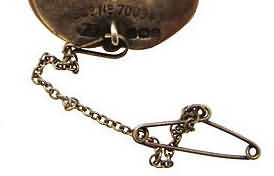
Safety Loops: Some
badges had loops for the attachment of a thin silver chain and tiny
safety pin. The latter was intended to prevent the badge falling off a
nurse's uniform if it
became unfastened. In practice it was probably only of value when
worn on indoor (ward) dress. The chains were fragile structures
and there were differences in quality and type of
chain and fittings though the majority seen are as illustrated here.
The loop was usually fitted on the lower edge on the reverse side,
as shown here (right), centrally between the hallmarks, but collectors will find badges where the
loop has been placed centrally at the top of the badge - right in the
centre of the Fattorini trade mark, defacing it. Such loops are almost certainly not
an approved fitting and were probably
 carried out privately after the
badge was issued. Damaging badges in this manner is clearly undesirable
from a collectable point of view, though how they affect the value of a badge, both as a
historic collectable and financially depends on a number of other
factors. Including the age and overall condition.
carried out privately after the
badge was issued. Damaging badges in this manner is clearly undesirable
from a collectable point of view, though how they affect the value of a badge, both as a
historic collectable and financially depends on a number of other
factors. Including the age and overall condition.
Fig1 above, showing the rear surface of five badges, illustrates many of
the essential differences. Not the only ones by any means. The next
article on collecting these badges will deal with each in more detail.
Conclusion:
The badges issued to
nurses who were registered by the General Nursing Council for England
and Wales are, without doubt, very collectable items simply as badges.
There are no doubt many badge collectors who possess examples simply
because they are badges and that is what they do for a hobby - collect
badges. Just as others collect stamps, paintings, train sets, coins et
al. But just as every collector has reasons for collecting particular
objects - and many create important contributions to specialist fields -
the fascination with collecting nursing badges has important
ramifications to a very precious and still relatively neglected commodity - the
history of the nursing profession.
That the history of nursing in England and Wales can be so readily
examined is due in no small part to the existence of these badges -
although that was never an objective of their design and manufacture.
Certainly the GNC badges from the early 1970's onward mitigated directly
against such links, if only as a side-effect of attempting to preventing
fraudulent use.
Earlier in this article the GNC State Registration badge was described
as
'a thing of three dimensional beauty - with a blue enameled
circle surrounding the central figure of Hygeia and the Welsh daffodils - in which, cast in
the metal of the badge, is the GNC title. Perfectly proportioned.
Perfectly executed. A perfect badge of recognition for a fully qualified
nurse at the end of three years - sometime more - of training.'
It is the latter part of the statement which personifies that which the
badge really represents. That which makes it so worthy - in case almost
without exception - of collection; preservation; of further study.
Between 1921 and1925 entry to the profession was permitted to nurses who could
prove the possession of sufficient experience as, laid down by statute, to gain registration.
Collecting badges with registration numbers prior to this means that the
badge was awarded on the basis of prior experience. Not as a result of a set GNC programme of training
and practical experience followed by theoretical and
practical examination. From
1925 entry was by undergoing a prescribed period of training passing the
theoretical and practical examinations of the GNC
for England and Wales. To achieve the latter it was essential to persuade the
existing professional leaders of suitability for entry - never an easy task - and
then to survive the obstacles - physical, intellectual, and moral, just to
reach the examinations. No easy task in a profession dominated for most
of it's existence by single ladies whose role in life centered around
the provision of the highest standards of care. And who demanded the
highest all round standards from those who sought to become registered
nurses.
That perfect badge
of recognition had to be earned... Not all entrants survived the course.
Of those who did, it is very often the case today that the badge is
the only obvious material evidence remaining of a career caring for the
sick. Every single one represents the career of a nurse. Every single
one is worthy of recognition.
Collecting GNC state registration badges can only help preserve nursing
history.* Having said that there is one area of collecting these badges
which, as in all other spheres of collecting, determines how collectible
these badges are. The cost.
Costs:
That nursing history may be regarded as priceless is one thing.
Having to foot the bill is quite another. So just what might it cost to
build up a collection of GNC State Registration badges? That will depend
on what sort of collection is required - which in this case is a bit
like asking the length of a piece of string and where the ends are -
after the string ends have been invisibly joined into a loop!
Best answered in detail after considering individual differences between
badges. But there are some basic guidelines. The first is that nursing
badges tend to be much more expensive than badges in general. At the
same time the cheapest state registration badges can be had at auctions,
flea markets and car boot sales for around £5 - £10. The more expensive
for around £18 - £35 on average for a rare silver version. Very rare
items in top condition may be had for around £50. There are some
extremely rare badges which, if they were ever to appear, would probably
command extremely rare prices!
A simple collection of perhaps one badge from each specialty (5
badges), would be possible for perhaps £55 - £100
from a source such as ebay. For this a collector could expect a
single item representing each main nursing specialty - in reasonable
condition - with original working pins and buying post 1940 items.
To Include an example of every Registration badge (7 badges - Mental Handicap
had three versions) might cost around perhaps £80 - £125.
Collecting one example every year of badge issue - a
collector could, ignoring specialty issues, collect perhaps 62 badges -
18 silver hallmarked and 44 chromium plated versions, for around £800
(44 at around £12 average and 18 at £20 average price). The reality
would probably work out at around £1000 - an average of approximately
£16 per badge. If one wanted a collection representing the main months
based on examinations (January; June; October - and allowing that
examinations did not commence until 1925) then, as a rough guide the
collector would be seeking around 174 badges. 45 Silver hallmarked
(Estimate £900) and 129 chromium plated versions (Estimate £1548). A
grand total of £2448. Ignoring specialties and expecting badges in
reasonable condition. One for collectors prepared to persevere - but
achievable.
Collecting individual specialties (5 badges) by year - Silver hallmarked
(where possible) £20 - £35 per badge. Chromium plated examples would
cost perhaps £5 - £15 each. Allow for possibly 62 examples in all cases
except Fever Nurses (RFN) where there are only 46 years to collect - 18
of which would be silver versions. Probably doomed to failure for all
but the SRN specialty.
A collection of all GNC State Registration badges is not possible
(unless the successors of the GNC inherited one) for the simple reason
that there were no set issue dates. A Registration badge could have been
issued for every weekday on the calendar (minus public and special
holidays) between the first issue in 1922 and the last in 1983! The
information just isn't available and any attempt to build such a
collection more than likely doomed to failure. Millionaires only.
My own belief is that a whole collection, including all the
nursing specialties, in excellent original condition from first issues
to the last, including 3 issues per year from 1925 could be put together
for between £3000 - £5000. Perhaps double if current market conditions
(June 2010) changed adversely. But any such collection would be worth a
considerable amount more, cost a considerable amount more in time
and effort, and would really be worthwhile for only a national
collection or a very wealthy private collector with infinite
patience.
The next article in this series will deal with individual badge
differences in more detail.
-------------------------------------------------------------------------------------------------------------------------------------------------------------------
Acknowledgements:
Sincere thanks to elaine3080 at ebay and
schoolsofnursing member Fran Biley for the supply and permission to use
the relevant photographs. All photographic layout design by
schoolsofnursing. All copyright asserted.
Notes:
There are still some figures relating to the number of badges issued to
the various specialties by particular dates which are outstanding.
These will be added to the article when they become available.
**Sterling Silver is an alloy of
92.5% Silver and 7.5% Copper. A guestimated
value of the silver content at a scrap value
is around 0.87 per gram (March 2010) would be around 87pence
per badge - a lot less than selling the badge in toto. Simply not worth it.
The average price of a silver GNC badge is around £12.00. Top prices
average around £25 - 30 at sales.
The last silver (not the last badge) State Registration badge was issued
(date) to Carol Green of the United Nottingham School of Nursing. The registration number was
500,000. It was specially made in silver to commemorate the 500,000th
registration of a nurse in England and Wales.
*It is the personal opinion of the author that there should be a
national collection of all UK nursing badges - possibly held by the
British Museum for the nation. It is my further belief that such a
collection should, if indeed it is still possible, contain a collection
of the badges issued to the original members of all the General Nursing
Councils. England; Wales; Scotland and Ireland. National collections of
these badges would be the property of the Nation, and be in addition to
any held by of representatives of the nursing profession or private
individuals. The British Museum would have statutory purchase rights as
in the case of treasure trove.
©WB/schoolsofnursing.co.uk

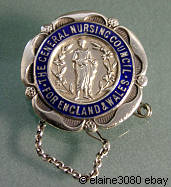
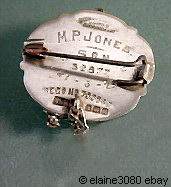
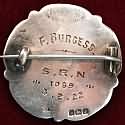
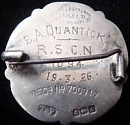
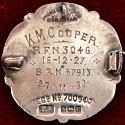
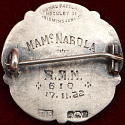
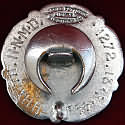

 This particular badge was made
and issued in 1929.The hallmarks
show that it was made by Thomas Fattorini - (T.F.) The Thomas Fattorini
registered assay mark......
assayed in Birmingham (vertical anchor) as .925 sterling silver (Lion). The
letter 'G' - the date stamp, is more problematic. There were several
other letters used and sometimes their use to attach a date a badge leads to
misleading descriptions. Badges are best described with the
nurses registration date, not the date of badge manufacture/assay.
This particular badge was made
and issued in 1929.The hallmarks
show that it was made by Thomas Fattorini - (T.F.) The Thomas Fattorini
registered assay mark......
assayed in Birmingham (vertical anchor) as .925 sterling silver (Lion). The
letter 'G' - the date stamp, is more problematic. There were several
other letters used and sometimes their use to attach a date a badge leads to
misleading descriptions. Badges are best described with the
nurses registration date, not the date of badge manufacture/assay. The second type of fitting was the button-hole, or lapel
fitting - which facilitated easy and secure attachment to the button
hole on a uniform jacket or gabardine rain coat. The central vertical
pier and circular fastening which arose from it meant that inscriptions
had to be placed around the edge. Consequently the appearance of the
reverse of this badge was definitely not pretty. Any nurse could ask for
this fitting, but could have only one badge. Not surprising then that
the fitting was not a popular option and was probably mostly selected by men - for
whom it may well have been intended. The manufacturer marks and
inscriptions varied in position.
The second type of fitting was the button-hole, or lapel
fitting - which facilitated easy and secure attachment to the button
hole on a uniform jacket or gabardine rain coat. The central vertical
pier and circular fastening which arose from it meant that inscriptions
had to be placed around the edge. Consequently the appearance of the
reverse of this badge was definitely not pretty. Any nurse could ask for
this fitting, but could have only one badge. Not surprising then that
the fitting was not a popular option and was probably mostly selected by men - for
whom it may well have been intended. The manufacturer marks and
inscriptions varied in position.
 carried out privately after the
badge was issued. Damaging badges in this manner is clearly undesirable
from a collectable point of view, though how they affect the value of a badge, both as a
historic collectable and financially depends on a number of other
factors. Including the age and overall condition.
carried out privately after the
badge was issued. Damaging badges in this manner is clearly undesirable
from a collectable point of view, though how they affect the value of a badge, both as a
historic collectable and financially depends on a number of other
factors. Including the age and overall condition.